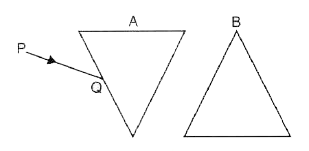If three identical prisms are combined is it possible to pass a beam that emerges undeviated? Undispersed?
Step by step video solution for If three identical prisms are combined is it possible to pass a beam that emerges undeviated? Undispersed? by Physics experts to help you in doubts & scoring excellent marks in Class 12 exams.
Updated on:21/07/2023Topper's Solved these Questions
- RAY OPTICSBOOK - AAKASH SERIESCHAPTER - RAY OPTICSEXERCISE - PROBLEMS ( LEVEL-I)
57 Videos
- RAY OPTICSBOOK - AAKASH SERIESCHAPTER - RAY OPTICSEXERCISE - PROBLEMS ( LEVEL-II)
60 Videos
- RAY OPTICSBOOK - AAKASH SERIESCHAPTER - RAY OPTICSEXERCISE - EXERCISE (SHORT ANSWER QUESTIONS )
24 Videos
- PRACTICAL PHYSICSBOOK - AAKASH SERIESCHAPTER - PRACTICAL PHYSICSEXERCISE - LECTURE SHEET LEVEL-II (ADVANCED) Linked Comprehension Type Questions
4 Videos
- SEMICONDUCTOR DEVICESBOOK - AAKASH SERIESCHAPTER - SEMICONDUCTOR DEVICESEXERCISE - EXERCISE - III
3 Videos
Similar Questions
A crown glass prism of angle 5∘ is to be combined with a flint prism in such a way that the mean ray passes undeviated. Find (a) the angle of the flint glass prism needed and (b) the angular dispersion produced by the combinatino when white light goes through it. Refractive indices for red, yellow, and violet light are 1.541, 1.517 and 1.523, repectively, for crown flass and 1.613, 1.620 and 1.632 for flint glass.
View SolutionThree identical resistors are connected in series . When a certain potential difference is applied across the combination , the total power would be dissipated is 27W. How many times the power would be dissipated if the three resistors were connected in parallel across the same potential difference ?
View SolutionA prism can produce a minmum deviation δ in a the beam. If three such prisms are combined, the minimum deviation that can be produced in this beam is
View SolutionThe refractive indices of the crown glass for violet and red lights are1.51and 1.49respectively and those of the flint glass are1.77and1.73respectively A prism of angle 6∘is made of crown glass .A beam of white light is incident at a small angle on this prism.The other thin flint glass prism is combined white the crown glass prism such that te net mean deviation is1.5∘anticlockwise.
(i)Determine the angle of the flint glass prism.

(ii)A screen is placed normal to the emerging beam at a distance of2mfrom the prism combination.find the distance between red and violet spot on the screen Which is the topmost colour on screen.
View SolutionA crown glass prism of angle 5∘ is to be combined with a flint glass prism in such a way that the mean ray passes undeviated. Find (a) the angle of the flint glass prism needed and (b) the angular dispersion produced by the combination when white light goes through it. Refractive indices for red, yellow and viloet light are 1.514, 1.517 and 1.523 respectively for crown glass and 1.613 1.620 and 1.632 for flint glass.
View SolutionHow will you use two indentical prisms so that a narrow beam of white light incident on one prism emerges out of the second prism as white light ? Draw the diagram.
View SolutionWhat is the cause of dispersion of white light through a glass prism Draw a ray diagram to show the path of light when two identical glass prisms are arranged together in inverted position with respect to each other and narrow beam of white light is allowed to fall obliquely on one of the faces of the prisms.
View SolutionThree identical rods are joined together to form an equilateral triangle frame. Its radius of gyration about an axis passing through a corner and perpendicular to the plane of the triangle is.
View SolutionHow will you use two identical glass prisms so that a narrow beam of white light incident on one prism emerges out of the second prism as white light? draw and label the ray diagram
View SolutionFigure below shows two identical prisms A and B placed with their faces parallel to each other. A ray of light of single colour PQ is incident at the face of the prism A. complete the diagram to show the path of the ray till it emerges out of the prism B.

View Solution
